
A | B | C | D | E | F | G | H | CH | I | J | K | L | M | N | O | P | Q | R | S | T | U | V | W | X | Y | Z | 0 | 1 | 2 | 3 | 4 | 5 | 6 | 7 | 8 | 9
| Valentine's Day | |
|---|---|
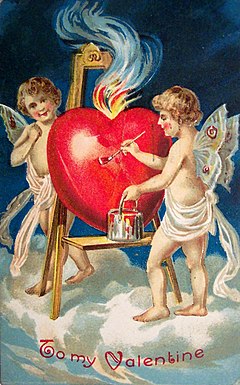 A Valentine's card, c. 1909 | |
| Also called | Saint Valentine's Day or the Feast of Saint Valentine |
| Observed by |
|
| Type | Christian, romantic, cultural, commercial observance |
| Significance | Feast day of Saint Valentine; the celebration of love and affection |
| Observances | Sending greeting cards and gifts, dating, church services, novenas |
| Date |
|
| Frequency | Annual |
| Part of a series on |
| Love |
|---|
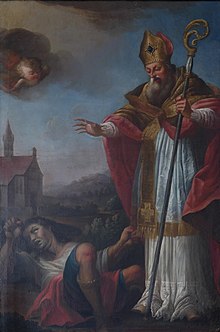
Valentine's Day, also called Saint Valentine's Day or the Feast of Saint Valentine,[1] is celebrated annually on February 14.[2] It originated as a Christian feast day honoring a martyr named Valentine, and through later folk traditions it has also become a significant cultural, religious and commercial celebration of romance and love in many regions of the world.[3][4]
There are a number of martyrdom stories associated with various Saint Valentines connected to February 14,[5] including an account of the imprisonment of Saint Valentine of Rome for ministering to Christians persecuted under the Roman Empire in the third century.[6][7] According to an early tradition, Saint Valentine restored sight to the blind daughter of his jailer.[8] Numerous later additions to the legend have better related it to the theme of love: tradition maintains that Saint Valentine performed weddings for Christian soldiers who were forbidden to marry by the Roman emperor;[7] an 18th-century embellishment to the legend claims he wrote the jailer's daughter a letter signed "Your Valentine" as a farewell before his execution.[9]
The 8th-century Gelasian Sacramentary recorded the celebration of the Feast of Saint Valentine on February 14.[10][11] The day became associated with romantic love in the 14th and 15th centuries, when notions of courtly love flourished, apparently by association with the "lovebirds" of early spring. In 18th-century England, it grew into an occasion for couples to express their love for each other by presenting flowers, offering confectionery, and sending greeting cards (known as "valentines"). Valentine's Day symbols that are used today include the heart-shaped outline, doves, and the figure of the winged Cupid. In the 19th century, handmade cards gave way to mass-produced greetings.[12] In Italy, Saint Valentine's keys are given to lovers "as a romantic symbol and an invitation to unlock the giver's heart", as well as to children to ward off epilepsy (called Saint Valentine's Malady).[13]
Saint Valentine's Day is not a public holiday in any country, although it is an official feast day in the Anglican Communion[14] and the Lutheran Church.[15] Many parts of the Eastern Orthodox Church also celebrate Saint Valentine's Day on July 6 in honor of Roman presbyter Saint Valentine, and on July 30 in honor of Hieromartyr Valentine, the Bishop of Interamna (modern Terni).[16]
Saint Valentine
History
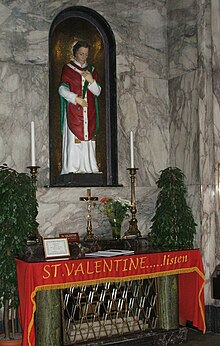
Numerous early Christian martyrs were named Valentine.[17] The Valentines honored on February 14 are Valentine of Rome (Valentinus presb. m. Romae) and Valentine of Terni (Valentinus ep. Interamnensis m. Romae).[18] Valentine of Rome was a priest in Rome who was martyred in 269 and was buried on the Via Flaminia. The relics of Saint Valentine were kept in the Church and Catacombs of San Valentino in Rome, which "remained an important pilgrim site throughout the Middle Ages until the relics of Saint Valentine were transferred to the church of Santa Prassede during the pontificate of Nicholas IV ".[19][20] The flower-crowned skull of Saint Valentine is exhibited in the Basilica of Santa Maria in Cosmedin, Rome. Other relics are found at Whitefriar Street Carmelite Church in Dublin, Ireland.[21]
Valentine of Terni became bishop of Interamna (now Terni, in central Italy) and is said to have been martyred during the persecution under Emperor Aurelian in 273. He is buried on the Via Flaminia, but in a different location from Valentine of Rome. His relics are at the Basilica of Saint Valentine in Terni (Basilica di San Valentino). Professor Jack B. Oruch of the University of Kansas notes that "abstracts of the acts of the two saints were in nearly every church and monastery of Europe."[22] A relic claimed to be Saint Valentine of Terni's head was preserved in the abbey of New Minster, Winchester, and venerated.[23]
The Catholic Encyclopedia speaks of a third saint named Valentine who was mentioned in early martyrologies under date of February 14. He was martyred in Africa with a number of companions, but nothing more is known about him.[24]
February 14 is celebrated as Saint Valentine's Day in various Christian denominations; it has, for example, the rank of "commemoration" in the calendar of saints in the Anglican Communion.[14] The feast day of Saint Valentine is given in the calendar of saints of the Lutheran Church.[15] In the 1969 revision of the Roman Catholic Calendar of Saints, the feast day of Saint Valentine on February 14 was relegated from the General Roman Calendar to particular (local or even national) calendars for the following reason: "Though the memorial of Saint Valentine is ancient, it is left to particular calendars, since, apart from his name, nothing is known of Saint Valentine except that he was buried on the Via Flaminia on February 14."[25] Therefore, as he remains within the Roman Martyrology, he may be recognised optionally during mass outside of Christmastide and Eastertide.[26]
The feast day is still celebrated in Balzan (Malta), where relics of the saint are claimed to be found, and also throughout the world by Traditionalist Catholics who follow the older, pre-Second Vatican Council calendar (see General Roman Calendar of 1960).
In the Eastern Orthodox Church, Saint Valentine is recognized on July 6, on which Saint Valentine, the Roman presbyter, is honoured; in addition, the Eastern Orthodox Church observes the feast of Hieromartyr Valentine, Bishop of Interamna, on July 30.[27][28][29]
Legends
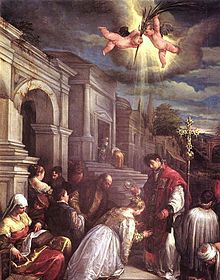
J.C. Cooper, in The Dictionary of Christianity, writes that Saint Valentine was "a priest of Rome who was imprisoned for succouring persecuted Christians."[30] Contemporary records of Saint Valentine were most probably destroyed during this Diocletianic Persecution in the early 4th century.[31] In the 5th or 6th century, a work called Passio Marii et Marthae published a story of martyrdom for Saint Valentine of Rome, perhaps by borrowing tortures that happened to other saints, as was usual in the literature of that period.[31][32]
The same events are found in Bede's Martyrology, which was compiled in the 8th century.[31][32] It states that Saint Valentine was persecuted as a Christian and interrogated by Roman Emperor Claudius II in person. Claudius was impressed by Valentine and had a discussion with him, attempting to get him to convert to Roman paganism in order to save his life. Valentine refused and tried to convert Claudius to Christianity instead. Because of this, he was executed. Before his execution, he is reported to have performed a miracle by healing Julia, the blind daughter of his jailer Asterius. The jailer's daughter and his forty-six member household, family members and servants, came to believe in Jesus and were baptized.[33][31]
A later Passio repeated the legend, adding that Pope Julius I built a church over his sepulchre (it is a confusion with a 4th-century tribune called Valentino, who donated land to build a church at a time when Julius was a Pope).[32] The legend was picked up as fact by later martyrologies, starting with Bede's martyrology in the 8th century.[32] It was repeated in the 13th century, in The Golden Legend.[34]
There is an additional embellishment to The Golden Legend, which according to Henry Ansgar Kelly, was added in the 18th century and widely repeated.[35] On the evening before Valentine was to be executed, he is supposed to have written the first "valentine" card himself, addressed to the daughter of his jailer Asterius, who was no longer blind, signing as "Your Valentine."[35] The expression "From your Valentine" was later adopted by modern Valentine letters.[36] This legend has been published by both American Greetings and The History Channel.[37]
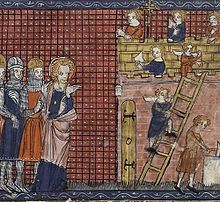
John Foxe, a 16th-century English historian, and the Order of Carmelites state that Saint Valentine was buried in the Church of Saint Praxedes in Rome, located near the cemetery of Saint Hippolytus. This order says that according to legend, "Julia herself planted a pink-blossomed almond tree near his grave. Today, the almond tree remains a symbol of abiding love and friendship."[38][39]
Another embellishment suggests that Saint Valentine performed clandestine Christian weddings for soldiers who were forbidden to marry.[40] The Roman Emperor Claudius II supposedly forbade this in order to grow his army, believing that married men did not make for good soldiers.[40][41] However, George Monger writes that this marriage ban was never issued and that Claudius II told his soldiers to take two or three women for themselves after his victory over the Goths.[42]
According to legend, in order "to remind these men of their vows and God's love, Saint Valentine is said to have cut hearts from parchment", giving them to these soldiers and persecuted Christians, a possible origin of the widespread use of hearts on Saint Valentine's Day.[43]
Saint Valentine supposedly wore a purple amethyst ring, customarily worn on the hands of Christian bishops with an image of Cupid engraved in it, a recognizable symbol associated with love that was legal under the Roman Empire;[41][44] Roman soldiers would recognize the ring and ask him to perform marriage for them.[41] Probably due to the association with Saint Valentine, amethyst has become the birthstone of February, which is thought to attract love.[45]
Folk traditions
While the European folk traditions connected with Saint Valentine and Saint Valentine's Day have become marginalized by modern customs connecting the day with romantic love, there are still some connections with the advent of spring.
While the custom of sending cards, flowers, chocolates and other gifts originated in the UK, Valentine's Day still remains connected with various regional customs in England. In Norfolk, a character called "Jack" Valentine knocks on the rear door of houses, leaving sweets and presents for children. Although he was leaving treats, many children were scared of this mystical person.[46][47]
In Slovenia, Saint Valentine or Zdravko was one of the saints of spring, the saint of good health and the patron of beekeepers and pilgrims.[48] A proverb says that "Saint Valentine brings the keys of roots". Plants and flowers start to grow on this day. It has been celebrated as the day when the first work in the vineyards and in the fields commences. It is also said that birds propose to each other or marry on that day. Another proverb says "Valentin – prvi spomladin" ("Valentine – the first spring saint"), as in some places (especially White Carniola), Saint Valentine marks the beginning of spring.[49] Valentine's Day has only recently been celebrated as the day of love. The day of love was traditionally March 12, Saint Gregory's day, or February 22, Saint Vincent's Day. The patron of love was Saint Anthony, whose day has been celebrated on June 13.[48]
Connection with romantic love
Possible ancient origins
The "Feast" (Latin: "in natali", lit.: on the birthday) of Saint Valentine originated in Christendom and has been marked by the Western Church of Christendom in honour of one of the Christian martyrs named Valentine, as recorded in the 8th-century Gelasian Sacramentary.[22][11] In Ancient Rome, Lupercalia was observed February 13–15 on behalf of Pan and Juno, pagan gods of love, marriage and fertility. It was a rite connected to purification and health, and had only slight connection to fertility (as a part of health) and none to love. The celebration of Saint Valentine is not known to have had any romantic connotations until Chaucer's poetry about "Valentine's Day" in the 14th century, some seven hundred years after celebration of Lupercalia is believed to have ceased.[31]
Lupercalia was a festival local to the city of Rome. The more general Festival of Juno Februa, meaning "Juno the purifier" or "the chaste Juno", was celebrated on February 13–14. Although the Pope Gelasius I (492–496) article in the Catholic Encyclopedia says that he abolished Lupercalia, theologian and Methodist minister Bruce Forbes wrote that "no evidence" has been demonstrated to link Saint Valentine's Day and the rites of the ancient Roman purification festival of Lupercalia, despite claims by many authors to the contrary.[notes 2][23][50][51]
Some researchers have theorized that Gelasius I replaced Lupercalia with the celebration of the Purification of the Blessed Virgin Mary and claim a connection to the 14th century's connotations of romantic love, but there is no historical indication that he ever intended such a thing.[notes 3][51][52] Also, the dates do not fit because at the time of Gelasius I, the feast was only celebrated in Jerusalem, and it was on February 14 only because Jerusalem placed the Nativity of Jesus (Christmas) on January 6.[notes 4] Although it was called "Purification of the Blessed Virgin Mary", it also dealt with the presentation of Jesus at the temple.[53] Jerusalem's Purification of the Blessed Virgin Mary on February 14 became the Presentation of Jesus at the Temple on February 2 as it was introduced to Rome and other places in the sixth century, after Gelasius I's time.[53]
Alban Butler in his The Lives of the Fathers, Martyrs, and Other Principal Saints (1756–1759) claimed without proof that boys and girls in Lupercalia drew names from a jar to make couples, and that modern Valentine's letters originated from this custom. In reality, this practice originated in the Middle Ages, with no link to Lupercalia, with boys drawing the names of girls at random to couple with them. This custom was combated by priests, for example by Frances de Sales around 1600, apparently by replacing it with a religious custom of girls drawing the names of apostles from the altar. However, this religious custom is recorded as early as the 13th century in the life of Saint Elizabeth of Hungary, so it could have a different origin.[23]
Chaucer's Parliament of Fowls

The first recorded association of Valentine's Day with romantic love is believed to be in the Parliament of Fowls (1382) by Geoffrey Chaucer, a dream vision portraying a parliament for birds to choose their mates.[31] Honouring the first anniversary of the engagement of fifteen-year-old King Richard II of England to fifteen-year-old Anne of Bohemia,[54] Chaucer wrote (in Middle English):
"For this was on seynt Valentynes day
Whan every foul cometh there to chese his make
Of every kynde that men thynke may
And that so huge a noyse gan they make
That erthe, and eyr, and tre, and every lake
So ful was, that unethe was there space
For me to stonde, so ful was al the place."[55][56]
In modern English:
"For this was on Saint Valentine's Day
When every bird comes there to choose his match
Of every kind that men may think of
And that so huge a noise they began to make
That earth and air and tree and every lake
Was so full, that not easily was there space
For me to stand—so full was all the place."
Readers have uncritically assumed that Chaucer was referring to February 14 as Valentine's Day. Henry Ansgar Kelly has observed that Chaucer might have had in mind the feast day of St. Valentine of Genoa, an early bishop of Genoa who died around AD 307; it was probably celebrated on May 3.[54][57][58] A treaty providing for Richard II and Anne's marriage, the subject of the poem, was signed on May 2, 1381.[59]
Jack B. Oruch notes that the date on which spring begins has changed since Chaucer's time because of the precession of the equinoxes and the introduction of the more accurate Gregorian calendar only in 1582. On the Julian calendar in use in Chaucer's time, February 14 would have fallen on the date now called February 23, a time when some birds have started mating and nesting in England.[31]
Chaucer's Parliament of Fowls refers to a supposedly established tradition, but there is no record of such a tradition before Chaucer. The speculative derivation of sentimental customs from the distant past began with 18th-century antiquaries, notably Alban Butler, the author of Butler's Lives of Saints, and have been perpetuated even by respectable modern scholars. Most notably, "the idea that Valentine's Day customs perpetuated those of the Roman Lupercalia has been accepted uncritically and repeated, in various forms, up to the present".[23][60]
Three other authors who made poems about birds mating on St. Valentine's Day around the same years: Otton de Grandson from Savoy, John Gower from England, and a knight called Pardo from Valencia. Chaucer most probably predated all of them; but due to the difficulty of dating medieval works, it is not possible to ascertain which of the four may have influenced the others.[61]
Court of love
The earliest description of February 14 as an annual celebration of love appears in the Charter of the Court of Love. The charter, allegedly issued by Charles VI of France at Mantes-la-Jolie in 1400, describes lavish festivities to be attended by several members of the royal court, including a feast, amorous song and poetry competitions, jousting and dancing.[62] Amid these festivities, the attending ladies would hear and rule on disputes from lovers.[63] No other record of the court exists, and none of those named in the charter were present at Mantes except Charles's queen, Isabeau of Bavaria, who may well have imagined it all while waiting out a plague.[62]
Valentine poetry
The earliest surviving valentine is a 15th-century rondeau written by Charles, Duke of Orléans to his wife, which commences.
"Je suis desja d'amour tanné
Ma tres doulce Valentinée..."— Charles d'Orléans, Rondeau VI, lines 1–2[64]
At the time, the duke was being held in the Tower of London following his capture at the Battle of Agincourt, 1415.[65]
The earliest surviving valentines in English appear to be those in the Paston Letters, written in 1477 by Margery Brewes to her future husband John Paston "my right well-beloved Valentine".[66]
Valentine's Day is mentioned ruefully by Ophelia in William Shakespeare's Hamlet (1600–1601):
"To-morrow is Saint Valentine's day,
All in the morning betime,
And I a maid at your window,
To be your Valentine.
Then up he rose, and donn'd his clothes,
And dupp'd the chamber-door;
Let in the maid, that out a maid
Never departed more."— William Shakespeare, Hamlet, Act IV, Scene 5
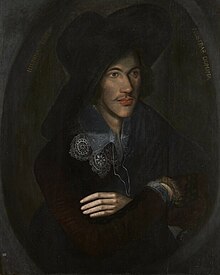
John Donne used the legend of the marriage of the birds as the starting point for his epithalamion celebrating the marriage of Elizabeth, daughter of James I of England, and Frederick V, Elector Palatine, on Valentine's Day:
"Hayle Bishop Valentine whose day this is
All the Ayre is thy Diocese
And all the chirping Queristers
And other birds ar thy parishioners
Thou marryest every yeare
The Lyrick Lark, and the graue whispering Doue,
The Sparrow that neglects his life for loue,
The houshold bird with the redd stomacher
Thou makst the Blackbird speede as soone,
As doth the Goldfinch, or the Halcyon
The Husband Cock lookes out and soone is spedd
And meets his wife, which brings her feather-bed.
This day more cheerfully than ever shine
This day which might inflame thy selfe old Valentine."
— John Donne, Epithalamion Vpon Frederick Count Palatine and the Lady Elizabeth marryed on St. Valentines day
The verse "Roses are red" echoes conventions traceable as far back as Edmund Spenser's epic The Faerie Queene (1590):
"She bath'd with roses red, and violets blew,
And all the sweetest flowres [sic], that in the forrest grew."[67]
The modern cliché Valentine's Day poem can be found in Gammer Gurton's Garland (1784), a collection of English nursery rhymes published in London by Joseph Johnson:
"The rose is red, the violet's blue,
The honey's sweet, and so are you.
Thou art my love and I am thine;
I drew thee to my Valentine:
The lot was cast and then I drew,
Modern times

In 1797, a British publisher issued The Young Man's Valentine Writer, which contained scores of suggested sentimental verses for the young lover unable to compose his own. Printers had already begun producing a limited number of cards with verses and sketches, called "mechanical valentines". Paper Valentines became so popular in England in the early 19th century that they were assembled in factories. Fancy Valentines were made with real lace and ribbons, with paper lace introduced in the mid-19th century.[70] In 1835, 60,000 Valentine cards were sent by post in the United Kingdom, despite postage being expensive.[71]
A reduction in postal rates following Sir Rowland Hill's postal reforms with the 1840 invention of the postage stamp (Penny Black) saw the number of Valentines posted increase, with 400,000 sent just one year after its introduction, and ushered in the less personal but easier practice of mailing Valentines.[72] That made it possible for the first time to exchange cards anonymously, which is taken as the reason for the sudden appearance of racy verse in an era otherwise prudishly Victorian.[73] Production increased, "Cupid's Manufactory" as Charles Dickens termed it, with over 3,000 women employed in manufacturing.[72] The Laura Seddon Greeting Card Collection at Manchester Metropolitan University gathers 450 Valentine's Day cards dating from early 19th century Britain, printed by the major publishers of the day.[74] The collection appears in Seddon's book Victorian Valentines (1996).[75]

In the United States, the first mass-produced Valentines of embossed paper lace were produced and sold shortly after 1847 by Esther Howland (1828–1904) of Worcester, Massachusetts.[76][77] Her father operated a large book and stationery store, but Howland took her inspiration from an English Valentine she had received from a business associate of her father.[78][79] Intrigued with the idea of making similar Valentines, Howland began her business by importing paper lace and floral decorations from England.[79][80]
A writer in Graham's American Monthly observed in 1849, "Saint Valentine's Day ... is becoming, nay it has become, a national holyday."[81] The English practice of sending Valentine's cards was established enough to feature as a plot device in Elizabeth Gaskell's Mr. Harrison's Confessions (1851): "I burst in with my explanations: 'The valentine I know nothing about.' 'It is in your handwriting', said he coldly."[82] Since 2001, the Greeting Card Association has been giving an annual "Esther Howland Award for a Greeting Card Visionary".[77]
Since the 19th century, handmade cards have given way to mass-produced greeting cards.[12] In the UK, just under half of the population spend money on their Valentines, and around £1.9 billion was spent in 2015 on cards, flowers, chocolates, and other gifts.[83] The mid-19th century Valentine's Day trade was a harbinger of further commercialized holidays in the U.S. to follow.[84]

In 1868, the British chocolate company Cadbury created Fancy Boxes – a decorated box of chocolates – in the shape of a heart for Valentine's Day.[85][86] Boxes of filled chocolates quickly became associated with the holiday.[85] In the second half of the 20th century, the practice of exchanging cards was extended to all manner of gifts, such as giving jewelry.
The U.S. Greeting Card Association estimates that approximately 190 million valentines are sent each year in the US. Half of those valentines are given to family members other than husband or wife, usually to children. When the valentine-exchange cards made in school activities are included the figure goes up to 1 billion, and teachers become the people receiving the most valentines.[76]
The increase in use of the Internet around the turn of the millennium is creating new traditions. Every year, millions of people use digital means of creating and sending Valentine's Day greeting messages such as e-cards, love coupons and printable greeting cards. Valentine's Day is considered by some to be a Hallmark holiday due to its commercialization.[87]
In the modern era, the Lutheran Church and Anglican Church each have a service on Saint Valentine's Day (the Feast of Saint Valentine), which includes the optional rite of the renewal of marriage vows.[88][89] In 2016, the Catholic Bishops of England and Wales established a novena prayer "to support single people seeking a spouse ahead of St Valentine's Day."[90]
Celebration and status worldwide
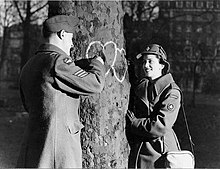
Valentine's Day customs—sending greeting cards (known as "valentines"), offering confectionery and presenting flowers—developed in early modern England and spread throughout the English-speaking world in the 19th century. In the later 20th and early 21st centuries, these customs spread to other countries, like those of Halloween, and aspects of Christmas (such as Santa Claus).
Valentine's Day is celebrated in many East Asian countries, with Singaporeans, Chinese, and South Koreans spending the most money on Valentine's gifts.[91]
Zdroj:https://en.wikipedia.org?pojem=Valentine’s_DayText je dostupný za podmienok Creative Commons Attribution/Share-Alike License 3.0 Unported; prípadne za ďalších podmienok. Podrobnejšie informácie nájdete na stránke Podmienky použitia.
Antropológia
Aplikované vedy
Bibliometria
Dejiny vedy
Encyklopédie
Filozofia vedy
Forenzné vedy
Humanitné vedy
Knižničná veda
Kryogenika
Kryptológia
Kulturológia
Literárna veda
Medzidisciplinárne oblasti
Metódy kvantitatívnej analýzy
Metavedy
Metodika
Text je dostupný za podmienok Creative
Commons Attribution/Share-Alike License 3.0 Unported; prípadne za ďalších
podmienok.
Podrobnejšie informácie nájdete na stránke Podmienky
použitia.
www.astronomia.sk | www.biologia.sk | www.botanika.sk | www.dejiny.sk | www.economy.sk | www.elektrotechnika.sk | www.estetika.sk | www.farmakologia.sk | www.filozofia.sk | Fyzika | www.futurologia.sk | www.genetika.sk | www.chemia.sk | www.lingvistika.sk | www.politologia.sk | www.psychologia.sk | www.sexuologia.sk | www.sociologia.sk | www.veda.sk I www.zoologia.sk

